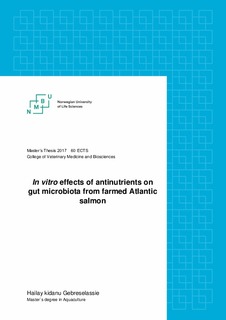| dc.description.abstract | Currently investigations on gut microbiota of animals and humans have received increased emphasis as it is thought to be a key factor in metabolism of nutrients, immune system, growth and protection against potential pathogens. Investigations on the effects of plant ingredients and fibers/NSPs on gut microbiota have been widely studied and implicated that their role shifts the level and composition of gut microbial communities. However, the presence of ANFs in plant ingredients effect on fermentation and gut microbiota is not clearly known. It was hypothesized that, inclusion of different levels of purified ANFs affect gut microbes including their proliferation, numbers, total composition and metabolic activity. As Atlantic salmon don not have functional enzymes to digest carbohydrate diets, the study of such changes is difficult to have in vivo study to ascertain the cause-effects of purified ANFs, because it is not possible to distinguish whether the outcome is due to the fibers/NSPS in SBM or due to the tested ANFs. Therefore, in this study, the use of in vitro simulation model mimicking microbial processes in salmon intestine was supposed to offer a suitable alternative to avoid such possible confounding effects as the results of these assays would be caused by the direct effects of individual and combined effects of purified lectin, saponin, isoflavonoid and phytosterol on fermentation and gut microbiota of farmed Atlantic salmon.
The changes in the bacterial levels and composition of farmed Atlantic salmon in response to the different ANFs were investigated by qPCR analysis. Parameters such as gas production, change in pH, redox potential, and levels of metabolites released were also used to estimate the effects on microbial fermentation. The total microbial counts tended to decrease linearly with increasing combination of antinutrients, particularly with saponin and isoflavonoid but their effects were not significantly different either from the control or the other levels. Saponin was relatively the most efficient ANF to decrease the total microbial levels. However, the lactic acid bacteria including lactobacillaeceae, and Bacilli were the most resistant towards the current levels of ANFs, instead they tended to increase their proportion with increasing ANF concentrations. In addition, though their level was very low, the aerobic bacteria represented a major cluster in microbial community, were resistant and would probably further increase their proportion. Of all the individual and combined antinutrients, saponin and isoflavonoid were the ones that showed relatively greater effects both in metabolic and microbial populations. Although, high level of lectin and low level of phytosterol were very effective to inhibit the growth of Vibrionaceae bacteria that contains some pathogenic species. At mid-concentration of all ANFs, pH was numerically lower than either the non-amended control, or low or high concentration, whereas the values for the high concentration was always numerically higher than non-amended control. This may indicate that at medium level these ANFs have stimulated the gut microbiota and increase fermentation process as reflected by pH reduction. On the contrary at high level of ANFs may affected the gut microbiota and inhibited the fermentation process. Although, the concentrations of the tested ANFs in this in vitro simulation was most likely exceed many-fold the concentrations in authentic salmon GI tract fed soy bean based feed, their effects both individually and in combination affected the microbial fermentation only little, which is different from what was predicted in the hypothesis. However, as there were some variabilities in regard to the effects of these ANFs, it is very difficult to generalize their effects on gut microbiota. Finally, it was suggested that the low incubation temperature and the high proportion of the frozen samples used as inoculum for the simulation model may affected the current results. Therefore, further studies with more samples and advance identification methods such as next generation sequencing is recommended to detect the high proportion of microbes remained uncaptured by the current method and smaller variations that may occur in the gut microbiota of fish. | nb_NO |

